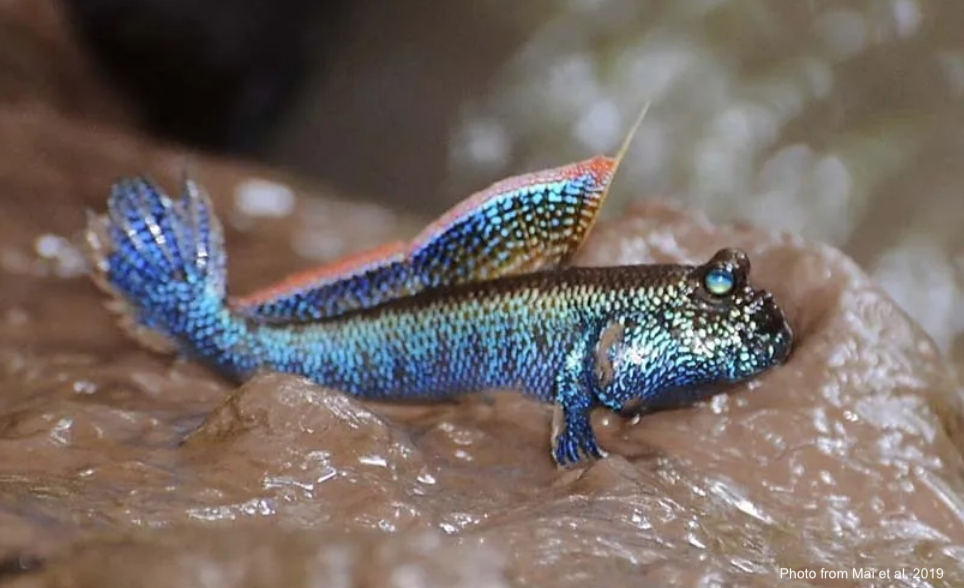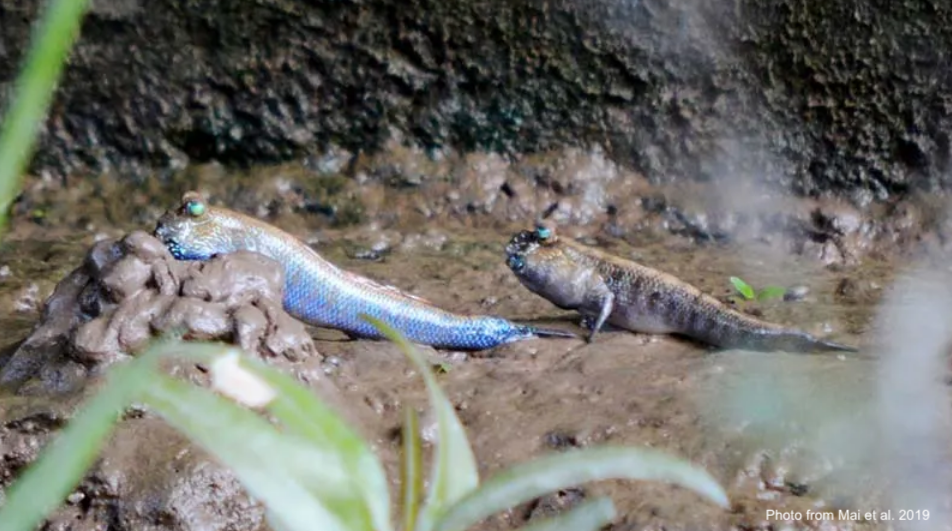Friday March 24, 2023

In this week’s Flashback Friday, we explore the mysterious biology of the mudskipper.
The mudskipper is a fish seemingly stuck in evolutionary limbo – one that can survive in both terrestrial and aquatic habitats. This amphibious fish has the unique ability to breathe air, and walk on land – spending most of its time above water in soft-bottom habitats like tidal mudflats, and the edges of mangrove forests. This preference for brackish habitats has scientists curious about this species’ evolutionary origins – did the mudskipper first emerge from marine or freshwater environments? To answer this question, a team of researchers conducted an analysis of the coastal evolution of the Mekong Delta, paired with an extensive observational study focused on Periophthalmodon septemradiatus, an abundant species of mudskipper that inhabits the lower reaches of the Mekong River. Their findings, published in Nature’s Scientific Reports, highlight aspects of the mudskipper’s ecology that point to probable emergence from environments of both fresh and brackish water, which could serve as a model for studying the evolution of other species (Mai et al. 2019).
The study encompassed several sample sites on the lower Mekong in Vietnam. At each site, the team measured a number of variables such as mudskipper abundance, observations of behavior, and various environmental measurements like temperature and salinity. The researchers focused on important ecological characteristics of the mudskipper, including where it breeds, feeds, and defends its territory, to make the most accurate estimate of its evolutionary origins. The data indicate that while reproduction was observed in both brackish and freshwater habitats, successful egg survival only occurred in brackish water. This type of behavior makes it the first fish of its kind to be observed inhabiting and attempting reproduction in two habitats of completely different salinity ranges in the same river. Based on the data gathered, the team ventures that the species of mudskipper in question most likely emerged from both fresh and brackish waters, rather than strictly marine habitats. Researchers involved in the study are especially interested in the role of salinity in biological and ecological changes of evolutionary transitional species like the mudskipper. This amphibious fish’s advancement to freshwater may indicate a trend that other brackish environment organisms could follow as river morphology changes over time. Throughout the entire duration of the study, the team never observed this species of mudskipper actually enter the water – indicating that this amphibious fish appears to be more terrestrial than aquatic. The research team believes that these ecological behavior changes may be explained by differences in salinity, which could be a subject of further study.

At the conclusion of the four-year study, the team of researchers have shed light on important clues to both the mudskipper’s origins and its evolutionary transition from water to land. The findings of this study hold important implications for the future conservation of the mudskipper in the Mekong river: their possible expansion into more freshwater environments of the lower Mekong may present additional threats to their populations in the face of continued habitat degradation. Scientists believe that, through studying the mudskipper’s evolutionary origins, we can learn more about what the transition process from water to land looks like in other vertebrate species. As sea levels rise and coastlines evolve, brackish habitats will experience changes in salinity levels. Changes to these environments over time will affect the way organisms interact with each other and their habitats – contributing to the larger process of adaptation and evolution. Research surrounding mudskipper behavior may help researchers keep pace with all aspects of this process, helping conservation science undergo an adaptation and evolution of its own as the world continues to change around us.
This story was written by Madisyn Pyorre for an internship with FISHBIO through the UC Santa Cruz Environmental Studies Department. This post was featured in our weekly e-newsletter, the Fish Report. You can subscribe to the Fish Report here.
